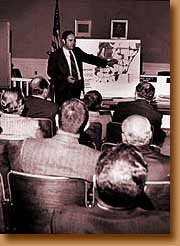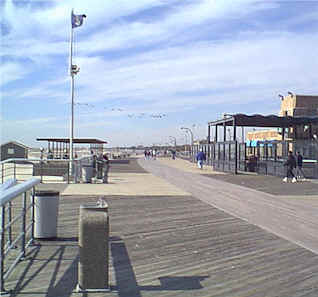A Remedy for the Rootlessness Of Modern Suburban Life?By Sarah BoxerAttacks on suburbia are as old as cul-de-sacs. Suburbs have always been derided as bourgeois, consumerist and conformist. But now they have become the enemy of family values, too. That's right. Karl Zinsmeister, the editor of the conservative magazine
The American Enterprise, has written that ''suburbia is actually a fairly radical social experiment,'' one that can be linked to ''the disappearance of family time, the weakening of generational links . . . the anonymity of community life, the rise of radical feminism, the decline of civic action, the tyrannical dominance of TV and pop culture over leisure time.''
What is to be done?
A group of architects and planners who have named themselves the Congress for the
New Urbanism have vowed to halt the spread of faceless, car-centered suburbs by promoting friendly, people-centered towns with corner stores and public greens.
They call for some old-fashioned things: walkable neighborhoods with a mix of residences, businesses and public places; straight and narrow streets; wide sidewalks, and no cul de sacs. They believe houses should be built close enough together and close enough to the sidewalks to define streets and public squares. Above all, they want strong town centers and clear town boundaries. No one, they believe, should live more than a five-minute walk from most of their errands. (Otherwise, what's to stop people from getting in their cars and driving?) And like their British counterpart, the
Urban Villages Group, the architects favored by the Prince of Wales, they want to preserve old towns and cities through ''infill,'' building on unused urban lots.
''No one can be opposed to those principles,'' said Alex Krieger, a professor of urban design at Harvard University. They are like ''mom and apple pie,'' he said. Yet many new-urban towns have been scorned as cutesy, regressive and un-urban. The new urbanists -- or neo-traditionalists -- should instead be called the ''new suburbanists,'' some say, because they are less interested in planning principles than in porches, picket fences and gabled roofs.
Seaside, designed in the early 1980's by Elizabeth Plater-Zyberk and Andres Duany, two of the founders of new urbanism, is the oldest new-urban town. Built on a stretch of the Florida panhandle, Seaside was meant to foster community life and beach access. The houses, a pastiche of historical styles in pastel colors, are set close to one another and connected by straight brick streets and a network of sand walkways cutting through the middle of each block. When the town is finished, it is supposed to have 350 houses and 300 apartments, a school, an open-air market, a town hall, a tennis club, an amphitheater, a post office, and a number of shops, offices and beach pavillions.
If you're having trouble picturing it, think of the idyllic town in the movie
''The Truman Show.'' That was no movie set. That was Seaside.
Since Seaside was built, new urbanism has won a lot of fans and building contracts. There are dozens of new-urban towns and projects built or under construction, including Celebration in Florida, Laguna West in California and Kentlands in Maryland. The Department of Housing and Urban Development is renovating some of its public housing according to new urbanist principles: more porches, more fences, lower buildings, narrower streets. Jane Jacobs, the author of ''The Death and Life of Great American Cities,'' has praised the movement as ''sound'' and ''promising.'' And publications from
The Sierra Club Yodeler to The American Enterprise have smiled on the new urbanists.
''But is their particular vision of urbanization an innovative model appropriate to the 21st century,'' Michelle Thompson-Fawcett asked in the journal Urban Design International, ''or is it regressive nostalgia?''
New urbanism is, by definition, nostalgic. Towns built on a human scale, with strong centers and clear edges, have been around for 5,000 years, said Robert Davis, the developer of Seaside and the chairman of the new-urban congress. It is only in the last 50 years, with the rise of modernism, he said, that Americans have forgotten how to build them.
The new urbanists want to induce neighborliness with architecture. In this sense they are utopian. Like the modernist master planners of the 1930's, they believe social change can be brought about through architecture and planning. The difference is that most of them hate modernism.
While the modernists ''tried to get to the future by destroying the past,'' Robert Fishman, the author of
''Bourgeois Utopias,'' said, the new urbanists ''are reviving the past in order to change'' the present. That, the new urbanists think, is why many architecture schools view them with contempt.
Most schools of architecture are ''so in the grips of the modernist ideology and so defensive of the avant-garde that they see the
Congress for the New Urbanism as fundamentally conservative,'' said Daniel Solomon, a founder of the movement. Peter Katz, the author of
''The New Urbanism: Toward an Architecture of Community,'' said that the nation's most powerful architects, particularly those in New York, ''laugh at the poor souls who live in suburbia.''
Kenneth Frampton, an architecture professor at Columbia University, agrees that many architecture schools (though he excludes Columbia) have ignored some questions about land settlement. But what bothers most professors about the new urbanists, he said, is not their critique of suburbia or land settlement. It is their design ideas.
The new-urbanist charter says nothing explicit about what styles are acceptable. Yet because many new urbanists believe that modernism ruined American cities, nearly all of their designs rely heavily on building styles from the past. Kentlands in Maryland is full of Georgian houses. Celebration, Disney's village in Florida, is full of brand new Victorians and Colonials.
''What's upsetting'' about new urbanism, said Mr. Frampton, ''is that the imagery is so retrograde.'' It is based on a ''sentimental iconography'' as if there were something inherently good about Victorians, Georgians and Colonials and something inherently bad about modernism. To be fair, there were a lot of modernists in the 1930's who advocated low-rise, high density housing, he said. Besides, the kind of modernism that the new urbanists see as their enemy is a straw man. No one is advocating tearing down whole cities to make way for skyscrapers.
''If you want to look for the demon that destroyed Main Street in America,'' Mr. Frampton said, ''it is not the modern movement but the American bureaucracy that opened the way for freeways and suburbanization.'' The railroads were deliberately undermined by the automobile industry, he said, adding, ''That was an economic, a capitalist, operation,'' not an architectural one.
New urbanism has not attacked the root of the problem sufficiently, suggested Alex Marshall, who has often written about new urbanism for
Metropolis magazine. ''What new urbanism tries to do is imitate older communities that existed before the automobile'' without getting rid of the automobile. But if you want to return to these older forms of life, he said, you ''have to bring back the transportation system.'' If you simply change the way houses are built, ''it's like changing hemlines.''
New urbanists like to see themselves as radicals, said Mr. Krieger, who was once a supporter of the movement and is now a critic. But, he added, they are ''no longer the radical fringe but conventional wisdom.'' Developers have begun using the term new urbanism to sell their projects.
That's not to say the movement hasn't had a good effect, Mr. Krieger said.
The Department of Housing and Urban Development has dedicated $2.6 billion to
''Hope Six,'' a nationwide plan to rebuild mid-century public housing according to new urbanist principles. From Boston to Cleveland to Helena, Mont., high-rise projects are being replaced by town houses with porches and fences. ''That is the part of the movement that most impresses me,'' said Mr. Krieger.
The problem, Mr. Marshall noted, is that most new-urban developments are not urban at all. They are rich developments on the town's edge. ''They are sprawl under another name,'' he said, and they are as restrictive as any suburban development. Most are privately run by homeowners' associations that give developers extraordinary control.
For example, in
Celebration, Disney's new-urban town, the deed restrictions specify what kind of drapery, roofing tiles and political signs are allowed. ''Disney has a history of making warm and fuzzy dog movies,'' said Evan McKenzie, the author of
''Privatopia,'' a book on housing associations, but ''they can take your dog if it makes too much noise.''
''It's as if the people are saying: 'Who needs democracy? It's utopia already!' '' said Mr. McKenzie.
People are looking for homeyness and safety, and they don't mind giving up some freedoms for it. In Kentlands, there is a gate in front of each entry into the development, Mr. Krieger said. ''It's a decorative gate but it evokes the same associations as a real gate. It's a subtle form of 'Keep Out.' ''
If decorative gates can evoke the same response as real gates, then maybe the look of neighborliness -- porches, wide sidewalks and village greens -- can evoke real neighborliness. Or can it?
The one big criticism about new-urban towns is that they are fake towns. Given that, it's curious that the developer of Seaside agreed to let ''The Truman Show,'' a movie about a real man in a false world, be filmed in Seaside. The movie all but said, ''This is not really a town but the shell of a town, an image of a town,'' Mr. Krieger said.
After the filming was over, the painted plywood storefronts that had been put up for the movie stayed up for months because the developer liked the way they looked, Mr. Krieger said. After all, looking like a real town is the next best thing to being one.
Copyright 2006 The New York Times Company. This article first appeard in The New York Times on August 1, 1998. Referenced links have been added by The Community Alliance.
- - -At The Community Alliance, we look to present diverse, and even controversial viewpoints concerning the growth and revitalization of suburbia, this in the hope of generating debate, and ultimately, fostering action on the issues -- be they economic, political, social or otherwise -- that impact upon America's first suburb, Nassau County, Long Island.Your opinions, comments, and Guest Blogs are appreciated and most welcome. E-mail us at info@thecommunityalliance.org.












